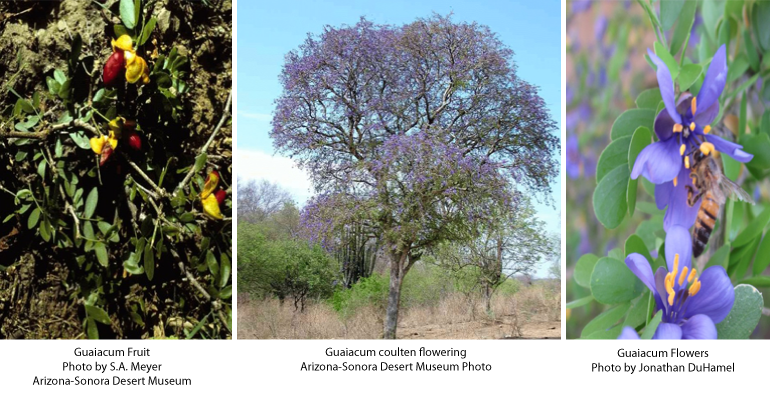
The Guayacan (Guaiacum coulteri ) is a flowering tree that produces bright purple flowers and tiny red fruit (about one inch long) during the summer. Guaiacum coulteri is a species in the caltrop family, that is native to western Mexico and Guatemala. The creosote bush is in the same family. You can see many of these trees at the Arizona-Sonora Desert Museum where they are now in flower. The heartwood of this tree, commonly called Lignum vitae, is claimed to be the hardest wood in the world. As such it has been extensively logged in its native habitat.
This plant is used in Arizona as an ornamental in xeriscape gardens. It grows upright and spreading to pendulous and weeping, sometimes to 20 feet, often lower to only 5 feet with an equal to slightly greater than equal spread. It is relatively frost tolerant to about 20 F (30 F according to some sources) but prefers warm temperatures and responds well to desert heat.
According to accounts of folk medicine in Mexico, Guayacan gum was used against syphilis and, in general, sexually transmitted diseases as well as arthritis, gout and asthma. It is also used as a laxative, diaphoretic, diuretic, and for pain relief. None of these properties has ever been studied and confirmed scientifically.
According to Wikipedia: “The 1955 edition of the Textbook of Pharmacognosy also says that: “Guaiacum has a local stimulant action which is sometimes useful in sore throat. The resin is used in chronic gout and rheumatism, whilst the wood is an ingredient in the compound concentrated solution of sarsaparilla, which was formerly much used as an alternative in syphilis.”
A phenolic compound derived from the resin of Guaiacum trees is used in a common test for blood in human stool samples. The presence of heme in the blood causes the formation of a coloured product in the presence of hydrogen peroxide. The effect of peroxidases in horseradish on guiacum was first noted in 1810 by Planche. As a food additive Guaiacum has the E number of E314 and is classified as an antioxidant. A widely used derivative drug is the expectorant known as guaifenesin.”
A small study from the Metropolitan Autonomous University, Mexico City, showed that Guaiacum coulteri was highly effective in treating hyperglycemia (high blood sugar). (Source)
Head out to the Arizona-Sonora Desert Museum to see Guayacans in bloom.
More ADI articles on desert plants:
Agaves provide food, fiber and adult beverages
Cactus water will make you sick
Chiltepin peppers, spice and medicine
Desert Broom – another medicinal plant
Desert Tobacco, a Pretty but Poisonous Desert Plant
Invasion of the Popcorn Flowers
Joshua Trees of the Mohave Desert
Medusa’s Head a strange and useful plant
Mesquite trees provide food, fuel, medicine, and more
Oak trees of the Sonoran Desert region
Ocotillo – an aide to hummingbirds and geologists
Palo brea trees and their uses
Palo Verde trees about to turn the desert golden
Sacred Datura – pretty, poisonous, and hallucinogenic
Saguaro Cactus Icon of the Sonoran Desert
Spectacular flowers of the red Torch Cactus
